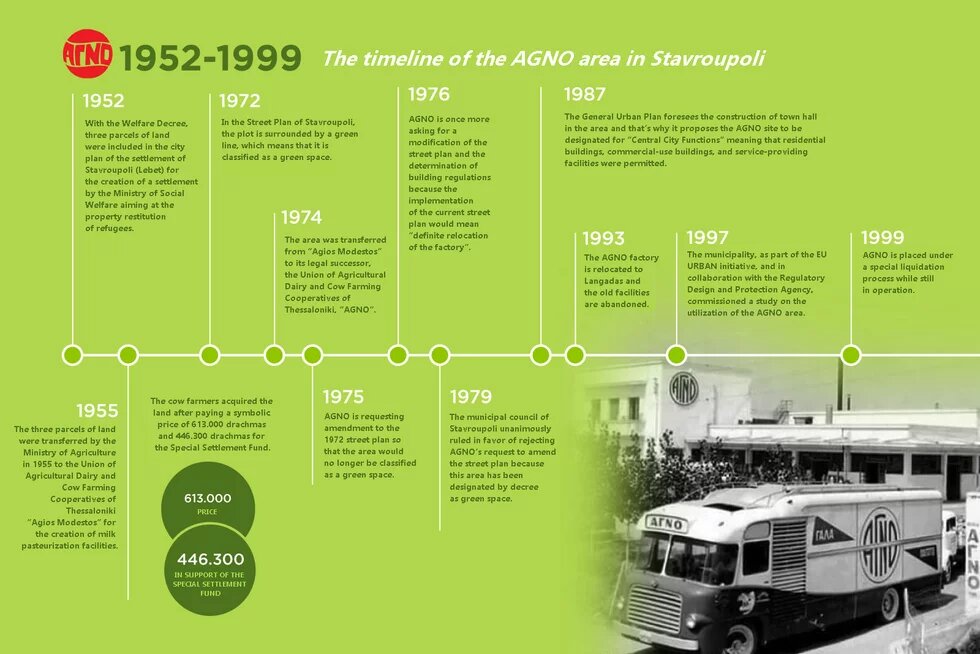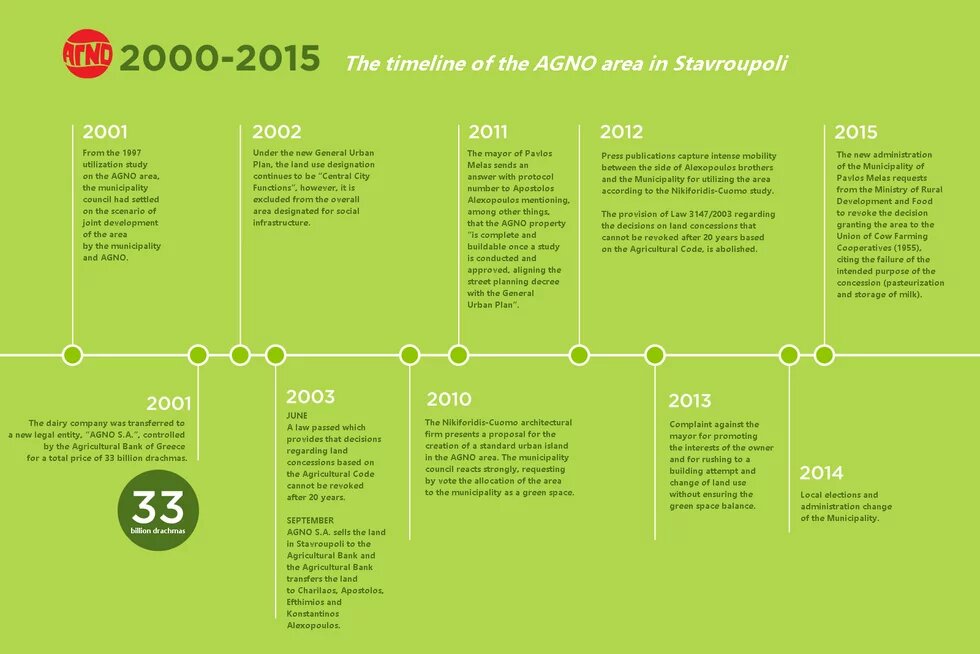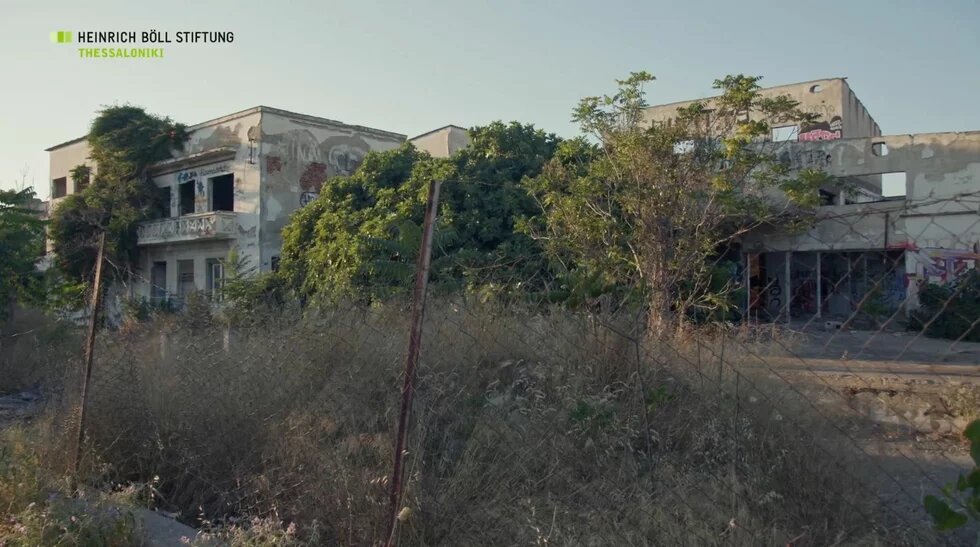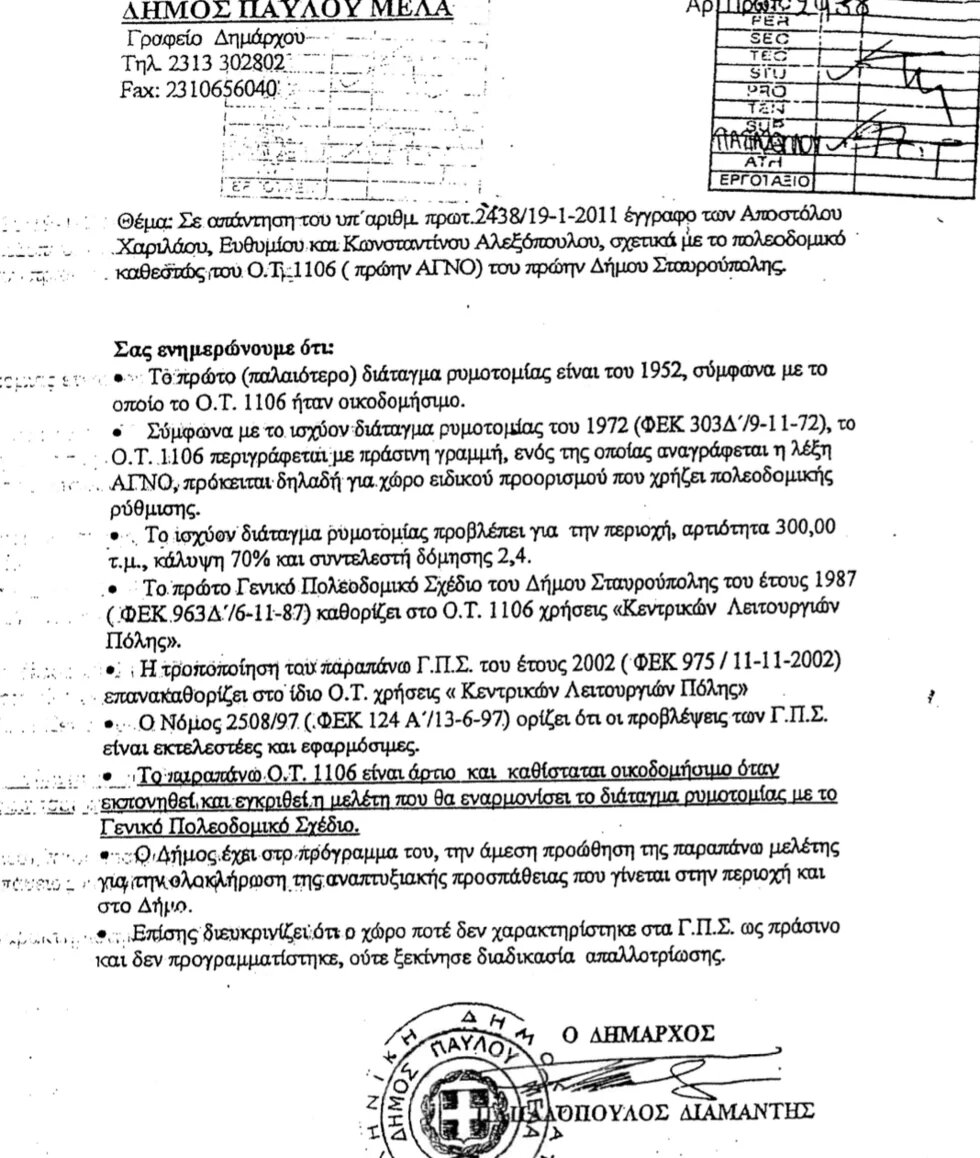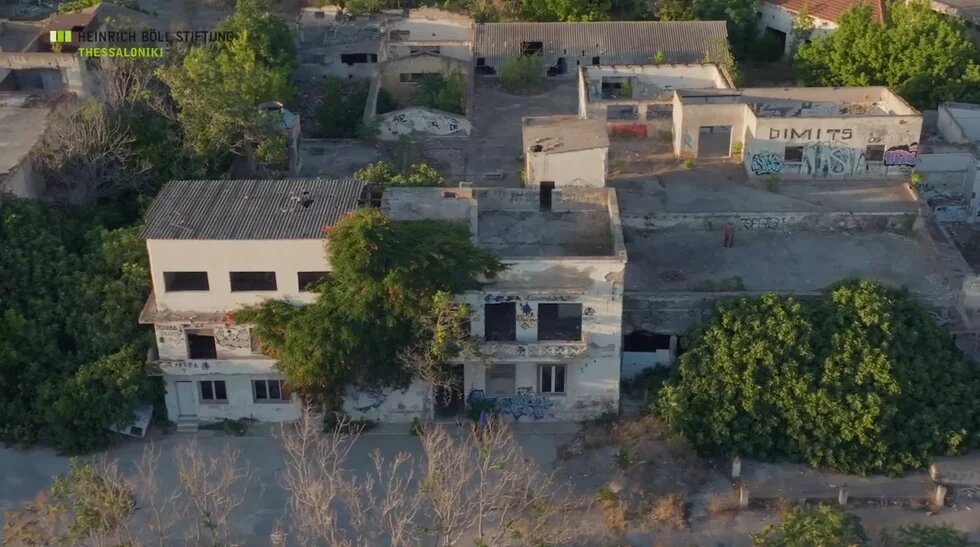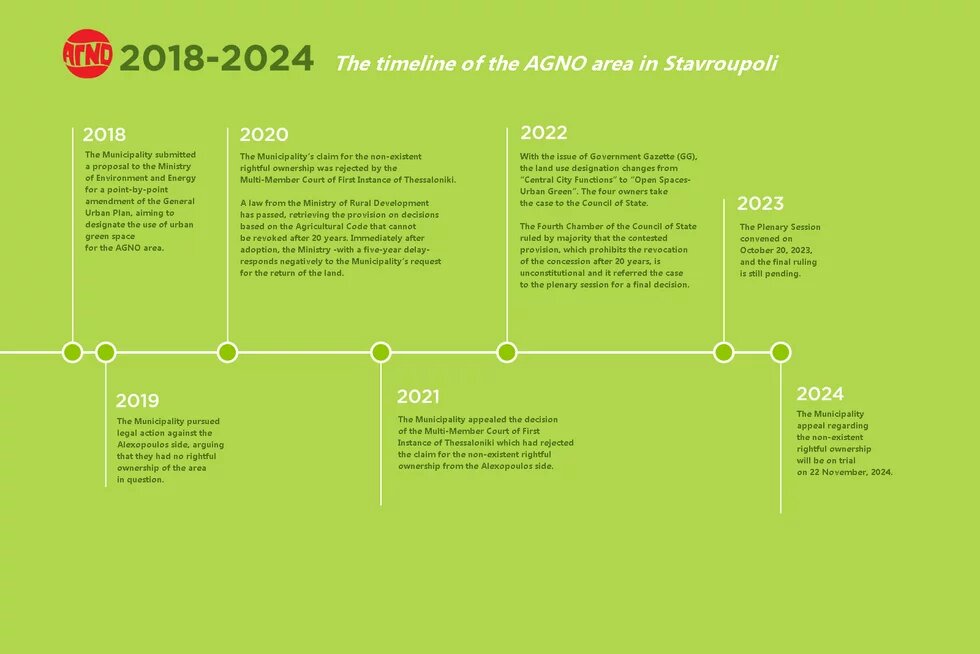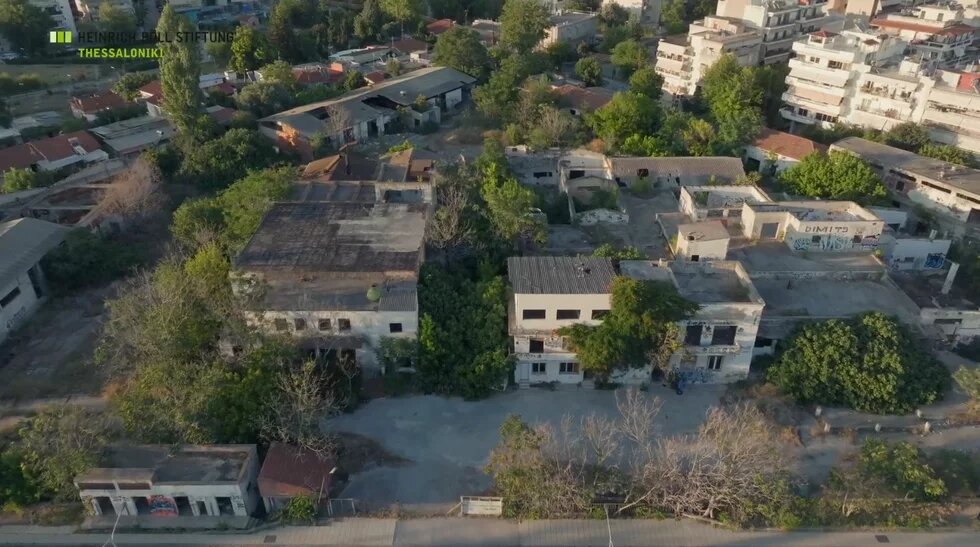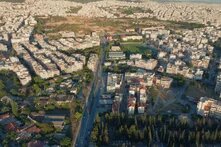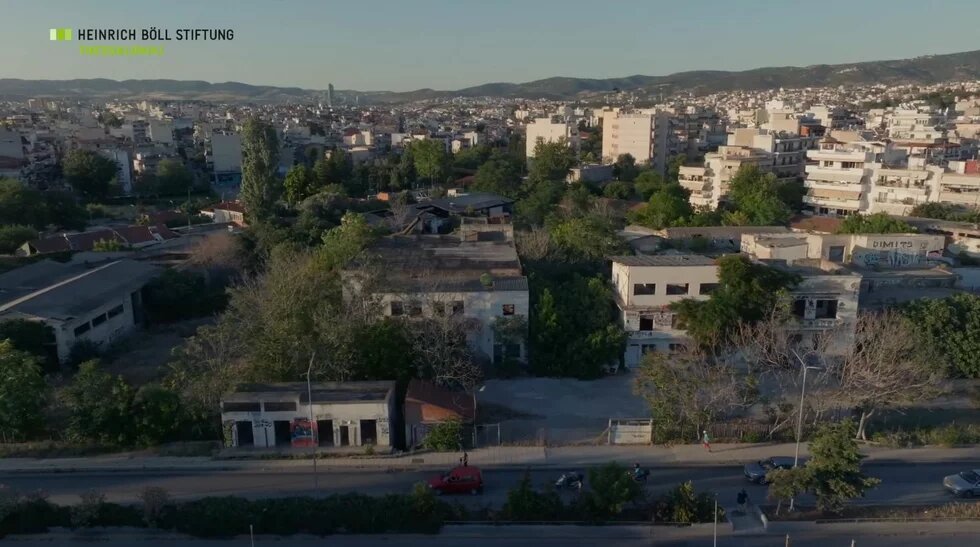
For over three decades, the area of the former dairy company AGNO in Stavroupoli, Thessaloniki, has been a parenthesis of almost 17.000 square meters in the urban fabric, filled with abandoned buildings and ruins. Although the area has been designated as public land since the early 1970’s, to this day the Municipality of Pavlos Melas has not been able to utilize the 16.900 square meters now located in the heart of the urban area, at the intersection of Karaoli & Dimitriou Street and Iasonidou Avenue. But neither the private individuals who have ownership titles can develop the land, until the pending court cases determine who ultimately owns the land.
This article follows the labyrinth route of this area, which was originally owned by the Greek state, granted for public benefit purposes and ultimately ended up being used as a private asset that can be mortgaged, seized and transferred to third parties. The area was originally intended for housing refugees from Asia Minor and was later granted to a cow farmers cooperative for the establishment of a milk pasteurization unit – both were public benefit purposes. The cooperative evolved into an anonymous company that went bankrupt, and the mortgaged area passed into the hands of a bank, which sold it to private individuals.
Alongside the changes in the ownership status, the article maps all the spatial planning actions taken by the then Municipality of Stavroupoli and subsequently the Municipality of Pavlos Melas, as well as the claim for the area using urban planning and legal means for the creation of green space.
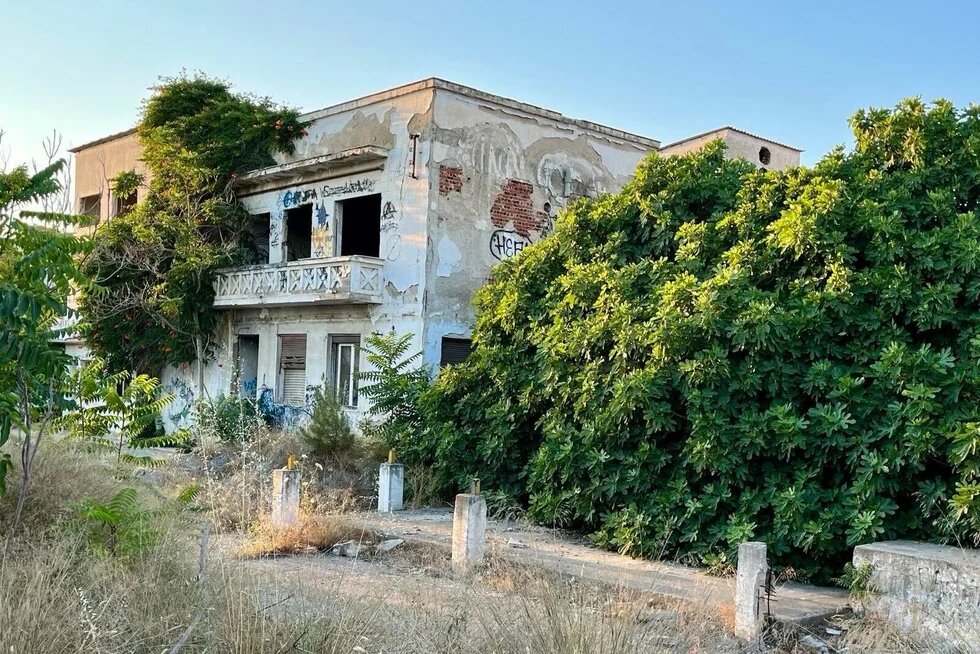
One area, two social purposes
In 1952, with the so-called Welfare Decree or Welfare Plan1, three parcels of land that were outside the city plan were included in the city plan of the settlement of Stavroupoli (Lebet) for the creation of a settlement by the Ministry of Social Welfare aiming at the property restitution of refugees, meaning those who had settled in cities2. Ultimately, the refugees’ settlement was never created at this location, because three years later the area was allocated for another social purpose: the pasteurization of milk. After a delay of two decades, Welfare would acquire a parcel of equivalent size in the area directly opposite the AGNO site, replacing the land it did not take in 1952. As explained by Asterios Goltsios, deputy head of the Urban Planning Department of the Municipality of Pavlos Melas, with the 1972 street plan of Stavroupoli three new building blocks were drawn in the area opposite Karaoli and Demetriou Streets, in the Terpsithea area, which were given for the needs of Welfare.
In the meantime, the parcels of land originally intended for the creation of a refugee settlement were transferred by the Ministry of Agriculture3 in 1955 (decision E/20990) to the Union of Agricultural Dairy and Cow Farming Cooperatives of Thessaloniki “Agios Modestos” for the creation of milk pasteurization facilities. In the facilities of AGNO, as the cooperative industry was called, milk pasteurization was carried out for the first time in Northern Greece.4
The land transfer was based on the provisions of article 123 par. 1 and 2 and the article 193 of the Agricultural Code5, which provided for the granting of land belonging to the former Refugee Rehabilitation Committee, managed by the Greek state, to agricultural cooperatives. The cow farmers acquired the land by title deed No 74.733/1955, after paying a symbolic price of 613.000 drachmas and 446.300 drachmas for the Special Settlement Fund. The relevant document from the Ministry of Agriculture states that the transfer of ownership was made without any conditions or purposes.
In a written briefing which we requested, the Urban Planning Department of the Municipality of Pavlos Melas claims that “this title is not restorative in nature, as the concession is intended to use the property for the purpose of the concession (in this case the pasteurization and storage of milk), without giving the concessionaire the right to dispose of the concession property, and is valid for as long as the property is used for the purpose of the concession”.
What does the green line around AGNO mean?
As we have seen above, the area originally intended for the creation of a refugee settlement was passed from the Welfare to the Cow Farmers Cooperative, while the 1972 Stavroupoli street planning decree6identified another area for the purposes of Welfare. In the same street plan, the block OT1106P, where the AGNO facilities had already been developed, is enclosed by a green line and the word AGNO is written within: “At that time, anything designated green had only a green line around it. Everything that was buildable had a green and a red line. OT1106P is marked only with a green line”, Mr. Goltsios clarifies, noting that the land which was previously intended for refugee settlement, i.e. having a residential use, is now designated as a green space.
On the same issue, an interesting intervention was made in 2010 by the then mayor Diamantis Papadopoulos at a city council meeting: “The Decree of Street Planning outlines the entire property with a green street line and shows the existing legal industrial building within the property, and it writes it down with the letters AGNO. The '72 Decree of Street Planning is awkward, and this makes sense because there is a new industry operating, to identify whether it is a block or not. It doesn't identify whether it's for public use, or whether it is public benefit in character. It simply designates it as an area within the city plan, and leaves it for future urban planning regulation or settlement”.7
We requested a comment from one of the property owners, Haris Alexopoulos, who responded: “This property was never designated as a green space. The Municipality refers to the 1972 street planning decree, which includes a green line, but this line is not a green space designation, it is a street planning line. The plan contained both green and red lines, street planning lines. A building permit had not yet been established”.
The Street Planning Decree caused “serious difficulties”
In 1974, the area was transferred from “Agios Modestos” to its legal successor, the Union of Agricultural Dairy and Cow Farming Cooperatives of Thessaloniki, “AGNO”. In November 1975, the Union of Cow Farming Cooperatives attempted to reverse the situation created by the Street Planning Decree by submitting a request to the then Municipality of Stavroupoli, in which it sought to amend the 1972 street plan so that the area would no longer be classified as a green space.8 A few months later, in August 1976, a request is being submitted again, once more asking for a modification of the street plan and the determination of building regulations for the block where its facilities were located. Addressing the Municipal Council, the cattle farmers pointed out: “We consider it necessary to highlight, although you are more aware of it than anyone else, the need for the aforementioned action, given that we are facing serious difficulties in continuing our work”.9 The nature of the serious difficulties caused by the “green space” designation is explained in the introductory report by surveyor engineer Nikolaos Nikiforidis, which accompanied the cattle farmers' request. Nikiforidis observed that the implementation of the street planning decree in the AGNO area “necessarily entails the relocation of the factory”. Instead of relying on legal arguments and urban planning regulations, the surveyor pointed to practical issues that would arise as the factory was the only one supplying dairy products to the city of Thessaloniki and a large part of Northern Greece, and also absorbing the milk production of a large number of stock breeders, so, “relocating it would mean ceasing operations for a considerable period of time and causing serious disruption to the smooth distribution of milk”.
However, the decision was likely not an easy one for the Stavroupoli Municipal Council, judging by the fact that it took three years to respond to the cow farmers. On August 30, 1979, the council unanimously ruled “in favor of rejecting the AGNO factory’s request to amend the street plan for the space it occupies, given that this area has been designated by decree as green space, which is essential for the region”.10
The green space balance
The 1979 Presidential Decree established building coefficients for areas within the Thessaloniki Urban Complex that had an approved street plan.11 In the urban planning unit of Welfare in Stavroupoli, where AGNO was located, a building coefficient of 2.4 was assigned. However, “according to the 1972 street plan, AGNO was not a buildable area, it was designated as green space”, notes Mr. Goltsios.
The General Urban Plan of Stavroupoli (GUP), ratified in 1987, proposed a different approach for the AGNO area compared to the 1972 Street Plan. The GUP assigned land uses and suggested that the AGNO site be designated for “Central City Functions”, meaning that residential buildings, commercial-use buildings, and service-providing facilities were permitted, however, without specifying whether the buildable space was intended for public or private buildings. The same Government Gazette (FEK) also mentioned the construction of a new town hall and the conversion of the existing one into a Senior Citizens’ Center.12 “The GUP provided that a town hall would be built within the designated block, so the area would not lose its public character,” argues Ast. Goltsios, Deputy Head of the Municipality's Urban Planning Department. He further notes that since the 1972 Street Plan had designated the space as green space, the 1987 GUP’s change of land use should have been accompanied by the designation of another area as green space to maintain the green space balance.13 It is important to note that, according to the case law of the Council of State (CoS), the final green space balance resulting from an “urban reconfiguration” must not be detrimental to public green spaces.
In the meantime, after the AGNO facilities in Stavroupoli were abandoned, the municipality approved a modification of the General Urban Plan in 2002, however, in block OT1106P, the status remained unchanged. The land use designation continued to be “Central City Functions”. However, a hash symbol (#) in the table14 listing each urban unit’s land requirements for social infrastructure (green spaces, schools, Senior Citizens’ Centers etc.) suggests that there was a pending issue regarding the AGNO site. Specifically, in the Welfare Urban Unit, 18,878 square meters were calculated as land allocated for social infrastructure, and the hash symbol referred to a note at the bottom of the table stating: “# The designated AGNO site was excluded from the calculation”.
In other words, the AGNO area was not calculated in the total land designated for social infrastructure, despite the fact that the 1972 Street Plan was still in effect, a plan that, according to the Municipality, classified the area as green space.
AGNO declares bankruptcy, the land changes hands
In the mid-1980s, construction began on AGNO’s new state-of-the-art factory in Lagadas, with costs exceeding 13 billion drachmas. In 1993, AGNO relocated to its new facilities. The study and construction of the new dairy factory in Langadas were undertaken by DOMOTECHNIKI, a company owned by the Alexopoulos family.
The old facilities were abandoned. In 1997, as part of the EU URBAN initiative, in collaboration with the Regulatory Design and Protection Agency, the municipality commissioned a study on the utilization of the AGNO area. The study proposed a comprehensive plan with three different scenarios for the development of the area. By 2001, the Municipal Council had settled on the third scenario, which proposed a joint development of the area by the municipality and AGNO.
Meanwhile, the EASTH-AGNO cooperative dairy industry faced severe financial difficulties and six years after its relocation, in 1999, it was placed under special liquidation while still in operation.15 The Agricultural Bank of Greece (ABG), as the company's largest creditor, took over the special liquidation process and announced a public auction for the sale of EASTH-AGNO’s entire assets. Finally, in 2001, the dairy company was transferred to a new legal entity, “AGNO S.A.”, controlled by the Agricultural Bank of Greece (ABG S.A. and ABG Holdings), for a total price of 33 billion drachmas (approximately 97 million euros).16
Two years later, in 2003, AGNO S.A. transferred its Langadas facility unit, along with the AGNO trademark, to Kolios S.A. As for the plot in Stavroupoli (OT1106P), AGNO S.A. sold it to the Agricultural Bank of Greece,17 which in turn transferred the land to Harilaos, Apostolos, Efthymios, and Konstantinos Alexopoulos individually (each holding a 25% undivided share), rather than to the family business DOMOTECHNIKI.18
The property was located within the city plan but was sold as a complete yet non-buildable plot because the municipality had not proceeded with the alignment of the Street Planning Decree with the General Urban Plan (GUP) (each specified different land uses) for the determination of the building lines and the construction coefficients. The new owners used the former AGNO dairy factory area as mortgage pre-notation for loans they obtained.
Development plans and reactions
In the following years, there were no changes to the urban planning status of the area, however, private initiatives emerged, with plans to develop and utilize the area.
In the fall of 2010, the Nikiforidis-Cuomo architectural firm presented a proposal for the creation of a standard urban island in the inactive land pocket of the former AGNO factory. The proposal was showcased as part of events marking 20 years of the magazine “Parallaxi” and was published in “Technographima“ of Technical Chamber of Greece/Section of Central Macedonia (TCG/SCM) and in the Greek Architecture Yearbook “DOMES”.19 In a related Voria report (November 2010), Efthymios Alexopoulos, vice president of DOMOTECHNIKI, was asked about the Nikiforidis proposal and stated: “Certainly, Mr. Nikiforidis’ idea can be considered interesting, and our company agrees, as we are interested in the Stavroupoli area and believe that at some point, it should be showcased. “In this context, Mr. Nikiforidis' proposal is fully aligned. However, we do not intend, at least for the time being, to engage with this particular project.” It is interesting to note that, at the time, the proposal, was not linked to the company but many years later, the same architect stated that in 2010, DOMOTECHNIKI had approached him and asked him to create a redevelopment plan for this specific building block.
The proposal sparked a reaction from the new municipal council of Stavroupoli, which was formed after the October 2010 elections. A month later, in a resolution, the municipal council expressed its strong concern and dissatisfaction because “a few days after the elections, the issue of the ‘development’ of the former AGNO factory was deemed necessary to be promoted by TCG/SCM, and in fact under the appealing title ‘green rooftops.’ It is surprising that the organizers of this event did not consider the involvement of our municipal authorities as a necessity in the discussion”.
The agitation of this issue at this particular moment is considered suspicious, given that this specific site was designated as green space by the 1972 decree. The Municipal Council calls on institutions, associations, and newly elected local government bodies to resist the concreting of the area under the misleading title ‘Green City’. It firmly expresses the unanimous demand of the local community for the site to be handed over to the Local Government as a green space.20
Seeking a beneficial solution
The noise around the AGNO area has quieted down for about two years. In July 2012, an article in the newspaper 'Naftemporiki' refers to preliminary studies and a 60 million euro investment in the AGNO area. Exactly during those days, a contract is drawn up that amends the September 2003 purchase and sale agreement between the Agricultural Bank and the Alexopoulos family, changing the installment amounts until the full payment of the price.21In October 2012, in a publication by Voria, the president of the DOMOTECHNIKI group, Ap. Alexopoulos, mentions that “in this period, the Municipality is taking action to issue the building regulations” and states that the project will proceed based on the design of architects Nikiforidis-Cuomo, and “aiming absolutely at synergies”. In December 2012, a publication by the newspaper ‘Agelioforos’ appears, stating that the Municipality of Pavlos Melas intends to give life to the 'shell' of the former factory, utilizing the existing study by architects Prodromos Nikiforidis, Bernard Cuomo, and Paraskevi Tarani. The publication mentions that “the study is already with the technical services of the municipality, while a presentation has also been made to the majority municipal group, where it was considered a beneficial solution for both the owner and the municipality”. The report includes statements from the mayor of Pavlos Melas, Diamantis Papadopoulos, who says, “we want the space to be utilized, and the ‘shell’ to be integrated into the life of the city”, and announces that after a discussion in the municipal council about the utilization plan, 'we will proceed with the alignment of the General Urban Plan with the Street Planning Decree”.
In the summer of 2013, the mayor of Pavlos Melas, Diamantis Papadopoulos, was accused22of “an unprecedented, blatant, and rushed maneuver aimed at promoting the interests of the landowner” and that “an attempt was being made to develop the plot with a building coefficient of 2.4 (allowing for the construction of 30,832 square meters), changing its designated use without ensuring the balance of green space within the same urban planning unit”.
Haris Alexopoulos, one of the owners, responded to our relevant question: “We had proposed to the Municipality to give them a significant building area to house public utility services. Initially, this was accepted, but at some point, the political considerations of various factions did not allow the plans to move forward”.
The Municipality decides to claim the area
In the meantime, the 2014 local elections took place, and the new administration of the Municipality of Pavlos Melas decided to claim the land. In 2015, it requested the Ministry of Rural Development and Food to revoke the decision granting the area to the Union of Cow Farming Cooperatives (1955), citing the failure of the intended purpose of the concession (pasteurization and storage of milk). Through the relevant correspondence, the Municipality sent all the necessary documentation to the Ministry of Rural Development and Food to substantiate its request, referring, among other things, to the revocation of similar concessions in Skydra. The Ministry’s response came five years later, by which time it had already amended the legislation upon which the citizens of Skydra had relied.
While awaiting the Ministry’s response, the Municipality of Pavlos Melas took legal action, filing complaints with the anti-corruption prosecutors of Athens and Thessaloniki, as well as with the Supreme Court (Areios Pagos), however, these cases have not yet reached a conclusion. Additionally, the Municipality pursued legal action against the Alexopoulos side, arguing that they had no rightful ownership of the area in question, however, its claim was rejected by the Multi-Member Court of First Instance of Thessaloniki. The Municipality appealed the decision in 2021, and the case remains unresolved.
A response from the mayor’s office from 2011
The publicity surrounding the case at the time prompted a response from Apostolos Alexopoulos, who cited a written reply from the Mayor’s Office of Pavlos Melas dating back to 2011, with protocol number 2438/21-6-11. This document stated that “the area was never designated as green space in the General Urban Plans and no expropriation process was ever planned or initiated”. The document mentions, among others, that:
- The first (oldest) street planning decree dates to 1952, according to which, block 1106 was designated as a buildable area.
- According to the current street planning decree of 1972, block 1106 is marked with a green line, within which the word AGNO is inscribed, indicating that it is a space designated for a special purpose that requires urban planning regulation.
- The first General Urban Plan of the Municipality of Stavroupoli and its modification define land uses of Block 1106 as “Central City Functions”.
- Block 1106 is considered a complete and buildable unit once a study is conducted and approved, aligning the street planning decree with the General Urban Plan.
- The Municipality has included in its agenda the immediate promotion of this study to complete the ongoing development efforts in the area and the Municipality.
For his part, Apostolos Alexopoulos mentioned that “contrary to common sense and the social and economic benefit of the Municipality, the Municipal Authority is belatedly raising the issue of disputing the status of property ownership, as if it does not know that this is undisputed and that a very high price was paid for its acquisition”.
Alignment of the GUP with the Street Planning Decree
As noted earlier, the Street Planning Decree and the General Urban Plan provided different designations for the AGNO area. Either the Street Planning Decree had to be modified and aligned with the GUP, making the area buildable, or the reverse had to happen, securing the land as a green space.
In 2018, the Municipality of Pavlos Melas submitted a proposal to the Ministry of Environment and Energy for a point-by-point amendment of the GUP of the former Municipality of Stavroupoli, aiming to designate the entire area of block 1106P for urban green space. The Municipality sought to align the 2002 G.U.P. with the earlier street planning decree of 1972, arguing that at the time, the balance of public spaces was not maintained for the designated green areas in the “Welfare” district of the Stavroupoli Municipal Unit. Eventually, the effort was successful, and in 2022, the relevant Government Gazette (FEK) was issued, officially changing the land use designation from “Central City Functions” to “Open Spaces-Urban Green (Green Spaces-Open Spaces: Squares, Parks, Playgrounds),” in accordance with Article 7 of Presidential Decree 59/2008.23 The Municipality spoke of vindication, and then mayor Dimitris Demourtzidis stated that “this paves the way for the creation of an urban green space that will enhance the urban built environment and become a major green ‘lung’ in a densely populated area, serving the residents of Stavroupoli”.
The four owners appealed to the Council of State regarding the decision for a point by point amendment.
Reversal by the Ministry of Rural Development
Meanwhile, in 2020, Law 4711/2020 of the Ministry of Rural Development was passed, which states, among other things: “The decisions issued in accordance with paragraphs 1, 3, and 4 of Article 123 of the Agricultural Code cannot be revoked, provided that the interested parties have achieved the purpose for which the decision was issued and twenty years have passed since the time of transcription of the relevant concession or decision”. With this provision, it appears that the transfer of the land from “Agios Modestos” to the Cooperative, as well as the subsequent transfers to the Agricultural Bank and the Alexopoulos side, cannot be disputed. An interesting detail is that the exact same provision regarding the irrevocability of the concession initially existed in Law 3147/2003. In fact, this law was passed in June 2003, and a few months later, in September 2003, the plot was transferred from the Agricultural Bank to the Alexopoulos side. The provision was subsequently abolished by Law 4061/2012, to be reinstated by Law 4711/2020.
Immediately after the enactment of Law 4711/2020, the Ministry of Rural Development responded —after a five-year delay— to the Municipality’s request for the return of the land. The response was that the request was rejected because “paragraph 18 of Article 36 of Law 4061, as added by Article 13 on special settlement issues of Law 4711/2020, applies, since the purpose of the concession has been fulfilled and 20 years have passed since the transfer of the ownership title, and specifically a period of 64 years has elapsed”.
Subsequently, the Municipality of Pavlos Melas appealed to the Council of State (CoS) on August 27, 2020, against the decision of the Department for Monitoring Granted Properties of the Directorate of Real Estate Management of the Ministry of Rural Development and Food, which was based on the above legal regulation of the law.
Council of State: Revocation when the public benefit purpose no longer exists
The Fourth Chamber of the Council of State ruled by majority that the contested provision, which prohibits the revocation of the concession after 20 years, is unconstitutional.24 The reasoning behind the decision is interesting.
The decision acknowledges that those land grants to Agricultural Cooperatives made under Article 123, paragraph 1 of the Agricultural Code “did not have a restorative character, as they were not made for restorative purposes”. That is to say, the land was granted to cooperatives not for their own restoration but to fulfill public benefit purposes, and in 1950s’ Greece, milk pasteurization was considered such a purpose. Additionally, the decision states that the cooperatives did not acquire full ownership rights but the concession “self-evidently included a reservation for revocation if the public interest reasons that justified the concession ceased to exist due to a complete change in the conditions and assessments that led to this concession”.
The ruling also notes that the revocation of a concession is allowed even when a price was paid (as in the case of AGNO), if it is considered that a condition of the concession has been violated.25
Furthermore, it holds that for properties actually used for 20 years for the purpose for which they were granted and were subsequently transferred to third parties, additional conditions must be met, otherwise, the State is deprived of its property “without serving a concurrent public purpose as required by the Constitution”.
The ruling concludes that the contested provision is unconstitutional and that concessions granted for the fulfillment of a specific public benefit purpose become revocable if that purpose is no longer served and these properties “do not become part of the private assets of the legal entity to which the concession was originally granted”.
The Fourth Chamber of the Council of State referred the case to the Plenary Session for a final decision. The Plenary Session convened on October 20, 2023, and the final ruling is still pending.
The then-Mayor of Pavlos Melas, Dimitris Demourtzidis, described the decision of the Fourth Section of the Council of State as a “crucial step towards final vindication”, which will restore the balance of public spaces in the ‘Welfare’ area of the Stavroupoli municipal unit and significantly enhance urban green spaces in western Thessaloniki.
The plans of the current administration of the Municipality of Pavlos Melas
“What we want is for the AGNO area to become a landmark for all Thessalonians and visitors to the city, a free recreational space where playgrounds, fitness and sports areas will coexist, adorned with trees and plants, a cradle of urban greenery”, says Theologos Papadopoulos, Deputy Mayor of Urban Planning and Design of the Municipality of Pavlos Melas. Born in 1988, the only images he has of the AGNO area are those of ugliness, as the facilities were abandoned in 1992. “I remember walking with my classmates in the 1990s towards the elementary schools of Ilioupoli while the whole area was filled with ruins. It is the personal challenge of my generation to see this space transformed into a green lung within a densely built and environmentally distressed area, leaving a positive mark on the local community for future generations”.
Currently, the AGNO plot contains 100 large and small buildings, and the cost of demolition alone is estimated at €1 million. A wall from the old factory facility on Iasonidou Street has started to tilt. “If it collapses, who will be responsible?”, we asked the Deputy Mayor. “The municipality has informed the entity it considers the legal owner, namely the Ministry of Rural Development, which then referred the matter back to the Municipality. Now, the Municipality can proceed with the demolition after notifying the prosecutor”.
If the Council of State’s Plenary Session rules in favor of the Municipality of Pavlos Melas, the municipality will then request the official transfer of the area from the Ministry of Rural Development to begin its transformation into a green space for public use by the local community.
The Alexopoulos side
We reached out to the Alexopoulos family for their stance on the issue. Haris Alexopoulos, one of the owners, stated: “The title was clear, absolutely clear, there was never any issue with it. The property was purchased from the Agricultural Bank (now Piraeus Bank), which had proper ownership titles. There are also court rulings in which the Municipality lost in the first instance and has since taken the case to the Council of State. I believe that justice will say the right thing, make the right decision. We are confident that reality is on our side, but in any case, regardless of the ruling, we will take the necessary steps accordingly. At this stage, no specific action has been planned in any direction. In any case, if municipalities want to designate an area as green space, they must also have the funds to compensate for it”.
If the Council of State's decision favors the private owners, Mr. Alexopoulos states that there is an intention to revive the development plan, “always with the social footprint we had previously proposed to the municipality, provided that the municipality is willing to do so. As a family, we always prioritize the social dimension of every issue, not just financial gain, we consistently consider the local community and its development. Unfortunately, the Municipality's stance is depriving residents of the opportunity to utilize perhaps the best and largest available plot in the area”.
The path of the pendulum
As seen above, the ownership status of the area has swung like a pendulum between the public and private sectors since the 1950s. The Council of State’s decision will ultimately determine whether a plot of land originally granted for public benefit purposes upon payment, can remain in the hands of the cooperative even after fulfilling its purpose of concession and subsequently become private property transferable to third parties or the concession should be revoked returning the land to the Greek state for public benefit purposes.
Footnotes
- 1In Royal Decree 321/A/13.11.1952, reference is made to the decision 52/12.2.52 of the Stavroupoli Community Council, to the 1803/51 act of the Settlement Council, and to the 796 opinion of the Council of State (CoS) on the proposal of the Ministry of Social Welfare.
- 2The Ministry of Social Welfare had a Directorate for the Resettlement of Urban Refugees, responsible for the resettlement of refugees who had settled in cities. Ownership (or the right to use, with a usage fee or free under lease) of a house, a shop, or a plot of land for self-housing was transferred to eligible beneficiaries.
- 3Decision E/20990 of the Directorate of Settlement of the Ministry of Agriculture.
- 4The mandatory pasteurization of milk in Greece began in September 1959 and was extended to Thessaloniki by the end of the year, despite opposition from cattle farmers and dairy shop owners. See Macedonia newspaper, 10-9-1959, and subsequent issues.
- 5Royal Decree of 29-10-1949, published in Government Gazette 342/A/1949.
- 6Government Gazette 303/D/9-11-1972.
- 7Pavlos Melas Municipal Council Meeting, 23-11-2010.
- 8Municipality of Stavroupoli, Protocol Number 6385/10-11-1975.
- 9Municipality of Stavroupoli, Protocol Number 3744/19-8-1976.
- 10Decision No. 131/79 of the Stavroupoli Municipal Council.
- 11Government Gazette 440/D/29-8-1979.
- 12Government Gazette 963/D/06-10-1987.
- 13After the approval of the 1972 street planning plan, the street layout and the new land measurement, the area of the former AGNO property was reduced to 12.8 acres.
- 14Page 8596 of Government Gazette 975/D/2002, Table A11.2.2, column “Institutionalized Land Urban Planning Study and Existing Street Plan”.
- 15By virtue of decision No. 3386/1999 of the Court of Appeal of Thessaloniki.
- 16Transfer agreement with No. 6.648/2001, volume 205, No. 256 in the Land Registry of Neapolis.
- 17Contract of sale No. 10.486/2003 by notary public Eleni Adamou, volume 236, No. 229 in the Land Registry of Neapolis.
- 18The total price was 6.237.000 euros. An amount of 637.000 euros was paid, and the remaining balance was agreed to be paid in 40 quarterly installments.
- 19DOMES (STRUCTURES), Volume A, 2011: “Proposal for redevelopment and integration of central functions on the site of the former AGNO, Stavroupoli, Thessaloniki”.
- 20Meeting of the Municipal Council of Pavlos Melas, 23-11-2010.
- 21Corrective contract No. 127534/2012, registered in volume 400, No. 280 in the Land Registry of Neapolis.
- 22Complaint from the SYRIZA party.
- 23Government Gazette 114A/29-6-2018.
- 24Decision 2606/2022 of the 4th Division of the Council of State.
- 25CoS 2504, 2199/2004, cf. CoS 623, 597/2021, 3104/2002, 1392/1985.



